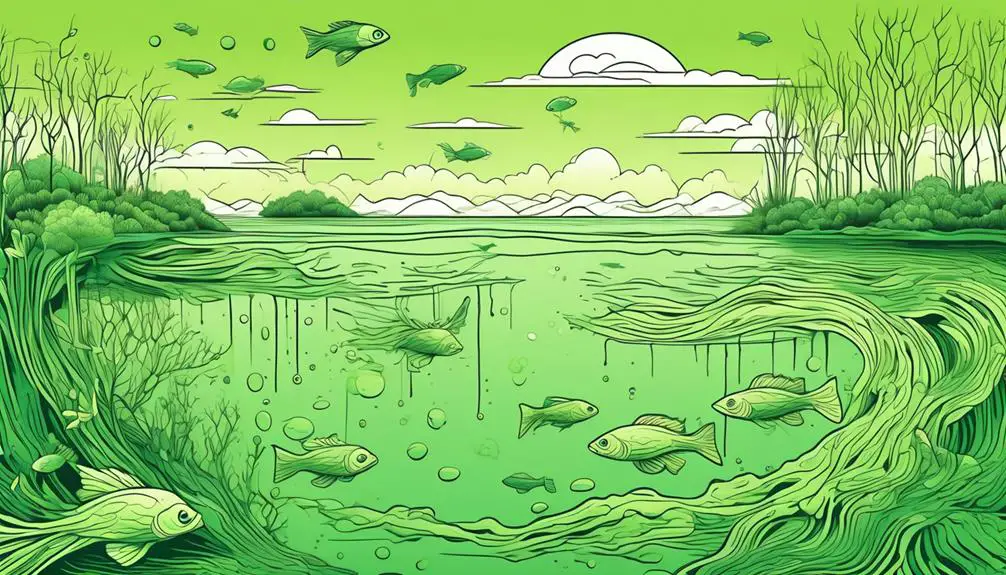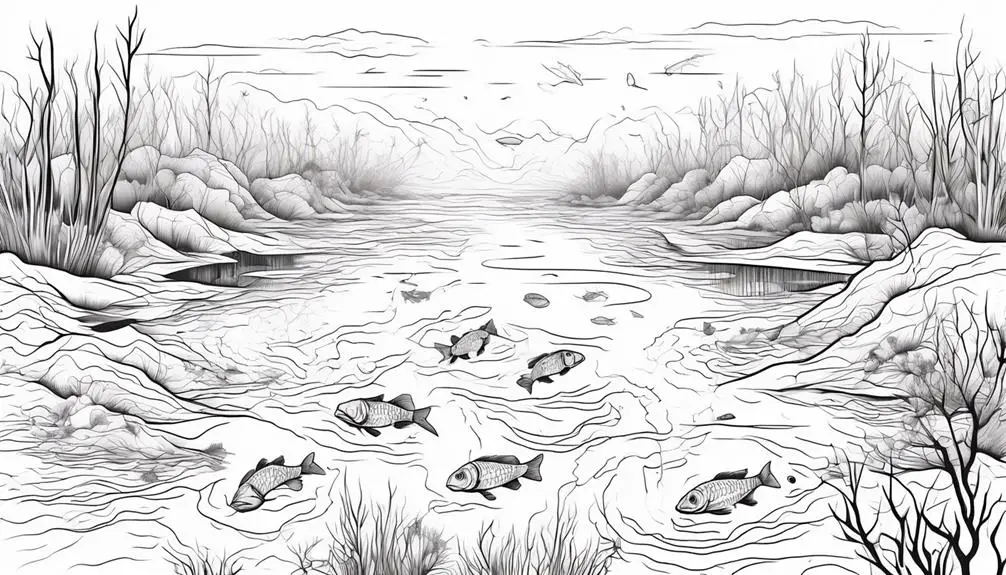Have you heard the saying, 'You reap what you sow'?
When it comes to water pollution's impact on biodiversity, this adage rings true. The repercussions of water contamination on various ecosystems are vast and profound.
From the disruption of food chains to the creation of dead zones, the effects ripple through both aquatic and terrestrial environments. The intricate web of life is intricately tied to the quality of our water systems, affecting everything from the tiniest organisms to the largest predators.
As we explore the intricate connections between water pollution and biodiversity, we uncover a complex tapestry of consequences that demand our attention and understanding.
Key Takeaways
- Pollution disrupts ecosystems and leads to a decline in species diversity.
- Dead zones in water bodies harm marine life and disrupt food chains.
- Aquatic flora and fauna are sensitive to pollutants, affecting crucial plant species.
- Toxic algae blooms and waterborne diseases threaten biodiversity and human communities.
Disruption of Food Chains
When pollutants enter water bodies, they begin a dangerous journey up the food chain, disrupting the delicate balance of ecosystems. Small animals ingest these pollutants, which then accumulate and spread up the food chain. This process leads to a chain reaction of disruptions, impacting various species along the way. From the smallest organisms to the top predators, no creature is spared from the effects of water pollution.
The impacts of water pollution on food chains extend far beyond just aquatic life. Excessive natural materials and nutrient buildup, often stemming from fertilizers, can throw off the balance of entire ecosystems. Birds, aquatic life, and even crops can be affected as they become contaminated by polluted water sources. As these contaminants move through the food chain, they not only endanger the survival of individual species but also jeopardize the overall biodiversity of the ecosystem. Water pollution poses a significant threat to the intricate web of life that relies on these interconnected food chains for survival.
Dead Zones
Dead zones are areas in bodies of water where marine life struggles to survive due to low oxygen levels caused by nutrient pollution. Excessive nutrients, mainly from sources like agriculture and sewage, lead to algae overgrowth, which depletes oxygen as it decays, creating these lifeless zones.
The impact of dead zones disrupts the balance of ecosystems, affecting fish, shellfish, and other marine organisms, highlighting the urgent need to address nutrient pollution for the preservation of biodiversity.
Marine Life Depletion
Amid the vast oceans, a troubling phenomenon known as marine life depletion, or dead zones, emerges due to low oxygen levels caused by pollutants such as agricultural runoff and sewage.
- Dead zones disrupt marine ecosystems, leading to mass die-offs of fish, shellfish, and other marine organisms.
- Nutrient pollution from fertilizers contributes to dead zones by fueling excessive algae growth, which depletes oxygen as it decomposes.
- Addressing nutrient pollution and improving water quality management are crucial in preventing the formation of dead zones and preserving marine biodiversity.
The polluted waters not only harm marine life but also have serious economic impacts, affecting fisheries and coastal communities that rely on healthy marine ecosystems. By understanding the causes of dead zones and taking steps to mitigate them, we can protect the diversity of marine life for future generations.
Ecosystem Imbalance
As we shift our focus to the issue of ecosystem imbalance, it becomes evident that the repercussions of marine life depletion extend beyond the loss of aquatic organisms to encompass broader disruptions in biodiversity caused by the prevalence of dead zones in water bodies. Dead zones, characterized by extremely low oxygen levels due to pollution, particularly from agricultural runoff and industrial discharges, harm fish, shellfish, and other marine life. This disruption in the food chain and biodiversity affects freshwater ecosystems significantly. Excessive nutrient influx, mainly nitrogen and phosphorus, fuels algae blooms that deplete oxygen as they decompose, exacerbating the dead zones. The impact on biodiversity includes reduced species diversity and altered ecosystem dynamics, showcasing the far-reaching consequences of ecosystem imbalance.
| Effects of Dead Zones | ||
|---|---|---|
| Harm fish and shellfish | Disrupt food chains | Reduce species diversity |
| Alter ecosystem dynamics | Impact freshwater ecosystems |
Impact on Aquatic Flora and Fauna
Hey there! Let's talk about how water pollution is impacting aquatic flora and fauna.
Aquatic plants are degrading, and fish populations are declining due to pollutants in the water.
This disturbance in the ecosystem is causing long-term harm to the delicate balance of aquatic life.
Aquatic Plant Degradation
Aquatic flora and fauna face significant threats from water pollution, particularly in the form of aquatic plant degradation.
- Aquatic plants are sensitive to pollutants, affecting the balance of ecosystems.
- Polluted rivers can lead to the decline of crucial plant species.
- Degradation can cause eutrophication and toxic algae blooms, harming aquatic life.
- Contaminated waters disrupt the food chain, impacting biodiversity.
Addressing pollution in rivers is vital to safeguarding plant health and preserving the delicate balance of aquatic ecosystems.
Fish Population Decline
With the degradation of aquatic plants due to water pollution, the decline in fish populations has emerged as a critical factor impacting the delicate balance of aquatic flora and fauna. Rising water temperatures further exacerbate this issue by affecting fish habitats and their ability to thrive. The table below illustrates the interconnected effects of pollution on fish populations and the broader aquatic ecosystem:
| Effects of Water Pollution on Fish Population Decline |
|---|
| 1. Decreased Reproductive Success |
| 2. Health Impacts on Fish |
| 3. Disruption of Ecological Balance |
| 4. Food Chain Imbalances |
| 5. Need for Conservation Efforts |
Understanding these impacts is crucial for implementing strategies to preserve fish populations and maintain biodiversity in aquatic environments.
Eutrophication Effects
Excessive nutrient buildup in water bodies can lead to eutrophication effects, causing harm to aquatic life by depleting oxygen levels. This process can have severe consequences on biodiversity, impacting genetic diversity within ecosystems.
- Disruption of Ecosystem Balance: Nutrient pollution, often from fertilizers, can stimulate excessive plant growth. This disrupts the natural balance of ecosystems, leading to a decrease in genetic diversity among species.
- Harmful Algal Blooms: Eutrophication can result in harmful algal blooms, which produce toxins that further degrade water quality. These blooms not only affect the health of aquatic organisms but also contribute to a decline in genetic diversity within the ecosystem.
- Loss of Species: Increased nutrient levels alter food chains and can lead to the loss of certain species. This loss directly impacts the genetic diversity of the ecosystem, affecting its overall health and resilience.
Toxic Algae Blooms Consequences

Toxic algae blooms have significant consequences on aquatic ecosystems, affecting biodiversity and posing risks to both wildlife and humans. These blooms can lead to the production of harmful toxins, causing fish kills and the deaths of various organisms in affected water bodies. Additionally, toxic algae blooms can create dead zones, depriving species of oxygen and disrupting the entire ecosystem. The toxins produced by these blooms also pose serious health risks to humans and animals that come into contact with contaminated water, highlighting the interconnectedness of water pollution and the well-being of flora and fauna. Furthermore, the economic impacts of toxic algae blooms can be substantial, leading to the loss of fisheries, recreational activities, and tourism opportunities in affected areas. The long-term ecological damage caused by these blooms can have lasting effects on biodiversity and the overall health of aquatic ecosystems.
| Consequences of Toxic Algae Blooms |
|---|
| Fish kills and organism deaths |
| Creation of dead zones in water bodies |
| Health risks to humans and animals |
Increased Waterborne Diseases
The impact of toxic algae blooms on aquatic ecosystems extends beyond immediate consequences, as increased waterborne diseases become a concerning health risk for both humans and wildlife due to water pollution. Here's why this is a critical issue:
- Transmission of Diseases: Polluted water sources facilitate the transmission of waterborne diseases like cholera, dysentery, and typhoid, affecting various species in aquatic and terrestrial habitats.
- Pathogen Proliferation: Pathogens thrive in contaminated water, directly threatening biodiversity and the overall health of ecosystems, leading to disruptions in food chains and population declines in affected species.
- Human Impacts: Contaminated water sources not only affect wildlife but also impact human communities reliant on these ecosystems for sustenance and livelihoods, highlighting the interconnectedness of ecosystem health and human well-being.
The spread of waterborne diseases due to pollution not only endangers the health of various species but also underscores the urgent need for effective measures to mitigate water pollution's detrimental effects on biodiversity and human populations.
Ecosystem Destruction

Amid water pollution, the destruction of ecosystems emerges as a critical concern, impacting the habitats of diverse species. Ecosystem destruction due to water pollution leads to the loss of critical habitats for various living things. Pollutants disrupt the balance of ecosystems at different levels, leading to a decline in biodiversity. The introduction of harmful substances into water bodies can result in the extinction of certain aquatic species, disrupting food chains and causing a ripple effect that affects wild animals dependent on these ecosystems. Industrial waste and the consequences of open access to water bodies contribute significantly to ecosystem destruction. Land use practices and climate change further exacerbate this issue. Below is a simplified representation of the impact of ecosystem destruction caused by water pollution:
| Ecosystem Destruction | Impact |
|---|---|
| Loss of critical habitats | Decline in biodiversity |
| Disruption of food chains | Extinction of species |
| Decline in plant and animal populations | Ripple effect on wild animals |
Species Loss
Water pollution poses a significant threat to the diversity of species by disrupting ecosystems and impacting the survival of various plants and animals. Here's why species loss is a critical issue:
- Endangered species are at high risk: Water pollution exacerbates the challenges faced by endangered species, pushing them further towards extinction.
- Habitat degradation leads to decline: Pollution degrades habitats, reducing available resources and shelter for a wide range of species, ultimately contributing to species loss.
- Disruption of food chains: Accumulated pollutants disrupt food chains, leading to the decline of certain species and upsetting the delicate balance of biodiversity.
The impact of water pollution on species loss is profound and far-reaching. By understanding how pollution affects different species and ecosystems, we can work towards solutions that protect and preserve the rich tapestry of life on our planet.
Frequently Asked Questions
How Does Water Pollution Affect the Biodiversity?
Water pollution disrupts ecosystems, harming small animals that ingest pollutants. These toxins accumulate, affecting biodiversity up the food chain. Contaminated water leads to issues like eutrophication and toxic algae blooms, impacting populations and food sources.
How Do Pollution Affect Biodiversity?
Pollution can devastate biodiversity. For instance, industrial waste in rivers can poison fish, disrupting the entire ecosystem. Be aware of the impact your actions have on the environment to help protect biodiversity.
How Does Water Pollution Impact the Ecosystem?
Water pollution disrupts ecosystems, harming aquatic life, birds, and crops. Contaminated water affects populations and food sources. Lead and cadmium spread through the food chain, impacting small animals and predators. It's crucial to address this issue promptly.
What Is the Impact of Water Pollution?
When water pollution strikes, it disrupts ecosystems, imperiling wildlife and habitats. From toxic algae blooms to contaminated food chains, the impact is vast. Embrace solutions to protect biodiversity and ensure a healthy environment.
Conclusion
Imagine a beautiful garden, teeming with diverse flowers and buzzing bees. Now picture that garden slowly being poisoned, the flowers wilting, and the bees disappearing.
This is what water pollution does to our ecosystems – it poisons the delicate balance of life, leading to a loss of biodiversity.
We must take action now to protect our precious water resources and preserve the beauty and richness of our natural world.